Page content
Fashions of Motherhood
by Linda Baumgarten
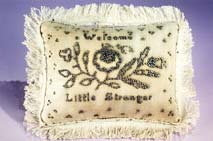
Welcome gift: Pins in cushion fastened children's clothing. G1971-1314.
Women's lives in the eighteenth century usually centered on their families; there was little likelihood of a career outside the home. Women went into childbirth uncertain not only of their own survival but of their child's, as well. It was not uncommon for a woman to give birth seven or eight times during her life, with only five or six children surviving to adulthood. Despite high mortality rates, women expected to have large families. Esther Edwards Burr, mother of Aaron Burr, was daunted by her future prospects after the birth of her second child. She wrote in 1756, "When I had but one Child my hands were tied, but now I am tied hand and foot. (How I shall get along when I have got ½ dzn. or 10 Children I cant devise.)"
Modern medical advances in industrialized societies today have led to smaller family size. More children escape once-fatal childhood diseases. Unborn children are no longer "little strangers." Nevertheless, we should not overemphasize differences from the past, for some human conditions have not changed. Parents of all eras have loved their children, nurtured them, given them playthings, dressed them in the prevailing fashion, and hoped for their happy future. All parents would subscribe to the sentiment on another eighteenth-century baby gift that reads, "Bright Be Thy Path Sweet Babe!
Women in the eighteenth century kept up an active schedule of work, social activities, and even exercise during their pregnancies. Englishman Dr. William Buchan wrote a "how to" book he titled Advice to Mothers in which he suggested that the best exercises--in moderation--were those to which a woman was already accustomed. He recommended
"Slow, short walks in the country, or gentle motion in an open carriage," particularly in the later months, and advised against dancing and other "great bodily exertions." Dr. Buchan observed that laboring countrywomen appeared to suffer no ill effects by continuing their work throughout pregnancy, only requiring a little "abatement" when their size made them "unwieldy."
Esther Edwards Burr was very active during her pregnancy. She went to public worship services, dined at the governor's, visited friends, hosted numerous guests in her home, and rode out in a chaise with her husband, nearly being injured when it overturned. On February 5, 1756, she attended a gathering of female friends who were planning yet another social outing, "a wedding Vissit." Esther was unable to attend because Aaron was born the very next day.
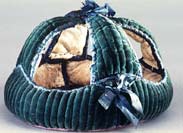
Quilted pudding cap made of velvet and stuffed with horsehair protected toddler from falls. 1952-55.
New Englander Elizabeth Porter Phelps rode into town and "drank tea at Brother Warners" one day before she went into labor with her first child. Frances Baylor Hill, a young Virginia woman, kept a journal in 1797 in which she described the activities of a pregnant friend, Sally Row. Sally continued to attend dinner parties less than a month before her child was born. Perhaps Sally was aware of warnings against vigorous activity, because at one outing, she quietly sat quilting with Frances while other friends were dancing.
Women had to cope with the difficulty of dressing for pregnancy in a time when the fashionable figure and undergarments called for tight lacing that shaped a woman's body into a smooth cone from the waist up to the breasts. In 1735, Sarah, Duchess of Marlborough, wrote her granddaughter reminiscing about her pregnancies and the clothing she resorted to in an attempt at comfort: "I remember when I was within three months of my reckoning, I could never endure any bodice [corset] at all; but wore a warm waistcoat wrapped about me like a man's and tied my petticoats on top of it. And from that time never went abroad but with a long black scarf to hide me I was so prodigeous big." (It is instructive to note that the duchess did not avoid going out, but covered herself with a scarf when she did.) The "warm waistcoat" described by the duchess was probably an unboned sleeveless garment that fastened at the front. In spite of the availability of looser waistcoats, some women continued to wear heavy stays or corsets during their pregnancies.
The French encyclopedia by Denis Diderot illustrates a pair of stays for wear during pregnancy; they have additional lacings at the side waist to allow expansion as a woman's body grew. As uncomfortable as stays sound to us, they did provide support for the back and helped maintain some semblance of the fashionable female figure by keeping a flat line at the bodice front, pushing the bosom up into a high, rounded shape. Although some criticized stays prior to the 1790s, the most vocal outbursts against them occurred after stays had been abandoned for fashionable reasons at the end of the eighteenth century. In an 1807 edition of Advice to Mothers, Dr. Buchan praised the new uncorseted fashions and described the former practice of wearing stays during pregnancy.
Among many improvements in the modern fashions of female dress, equally favourable to health, to graceful ease and elegance, the discontinuance of stays is entitled to peculiar approbation. It is, indeed, impossible to think of the old straight waistcoat of whalebone, and of tightlacing, without astonishment and some degree of horror . . . I need not point out the aggrevated mischief of such a pressure on the breasts and womb in a state of pregnancy. Unfortunately, fashion later in the nineteenth century returned to corseting and constricted the waistline as much as or more than it had in the previous century.
Few maternity gowns survive in museum collections. Colonial Williamsburg has only one. Women altered their usual clothing in an era when most could not afford large wardrobes or clothing designed specifically for pregnancy. Women's styles were surprisingly adaptable to changes in size. Many gowns fastened at the front with hidden lacings that could be let out to accommodate the new figure. If the triangular stomacher no longer fit the front of the enlarged gown, the front could be filled in with a large neck handkerchief worn much like a shawl. Petticoats usually fastened at either side with ties, and thus could continue to be worn during pregnancy by loosening the ties. Women merely tied their petticoats up over their abdomens, hiking up the hems at the front as a result. Print sources suggest that no attempt was made to adjust hemlines to make the skirts hang evenly in front.
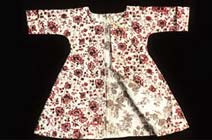
Women's thigh-length Short Gown from the late 18th century could have served as a loose-fitting maternity garment. 1985-242.
Another garment easily adapted to pregnancy was a loose, unfitted gown with a shortened skirt that was worn with a petticoat as a two-piece outfit. Variously called a "bedgown" or "short gown," this style was not limited to maternity wear, but was the everyday dress of many working women as a comfortable alternative to fashionable but tight gowns. Because they were cut full and loose, pregnant women could wear bedgowns without altering them.
The high-waisted, uncorseted styles of the turn of the century were even more convenient. They were usually fitted to the upper body with drawstrings that could be loosened as necessary. The absence of a natural waistline made camouflage and fit easier than it had been in the past.
One of the most characteristic garments worn by pregnant women was a long apron tied over the clothing under the breasts and covering the abdomen. As early as 1669, diarist Samuel Pepys associated an apron with pregnancy: "I waited upon the King and Queen . . . she being in her white pinner and apron, like a woman with child."
Wearing aprons to camouflage pregnancy continued in the eighteenth century; even children seemed to associate the wearing of aprons with pregnancy. Philip Vickers Fithian, tutor to the Robert Carter children in Virginia, described the antics of two of his little charges: "Fanny and Harriot by stuffing rags & other Lumber under their Gowns just below their Apron-Strings, were prodigiously charmed at their resemblanc [sic] to Pregnant Women!"
Throughout much of the eighteenth century, most women kept to the practice of "lying in" for about a month following delivery to regain their strength. By the end of the century, this long period was shortened to two weeks or ten days.
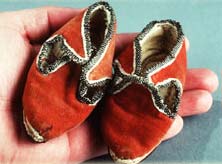
Tiny velvet shoes are from first half of 17th century. Infants' shoes rarely survived, as they often were passed down and worn out. 1985-226.
Although bottles were not unknown, most eighteenth-century women breast-fed their children for at least a year. In fact, breast-feeding became increasingly fashionable during the century. Queen Caroline, wife of George II of England, breast-fed all of her children. For those unable or unwilling to breast-feed, wet nurses could be hired to take over the task. Esther Burr, who had been breast-feeding her five and one-half-month-old son, hired a temporary wetnurse when she had to travel with her husband. Referring to Aaron's nurse, she wrote in the diary, "have got the best Woman in Town for that purpose to late and suckle it."
The phrase "to late" probably derives from the French allaiter, meaning to nurse or suckle
Most women undoubtedly wore their usual clothing while nursing. If a woman wore stays, she may have chosen those with front rather than back lacings and less heavy boning. A rare pair of elaborate brocaded silk stays in the Colonial Williamsburg collection has a flap opening over each breast, in all likelihood as a convenience during nursing; the stays lace at both the front and back.
Weaning occurred when a child was between one and two years of age. Esther Burr weaned Aaron when he was about fourteen months old. She complained, "I am Weaning Aaron and he makes a great Noise about it." Sometimes a child was weaned abruptly by sending it away from home for several weeks. In January 1797, Frances Baylor Hill recorded in her journal that she "Took Hetty Row that night to wean[.] she cri'd and scuffled a little at first but slept tolerable well that night." Nine days later, Frances was still being kept awake by little Hetty, whose parents finally came and got her fifteen days later.
A child's first solid food consisted of pap, a soft mixture of bread or meal moistened with milk or water, and sometimes laced with beer. Papboats were designed with spouts from which the pap could be fed directly into the child's mouth.
Children's clothing underwent significant changes during the eighteenth century. As the century began, some parents still wrapped their newborns in swaddling bands for several months after birth. Swaddling consisted of wrapping the infant's body tightly with narrow bands of fabric called "rollers." The baby's head was immobilized with a separate stay band. A critic of the practice noted that the result was to render the child "as stiff as a log of wood."
The writings of John Locke argued against physical constraints for children, particularly tight swaddling. Locke's ideas were expanded and popularized by the publication of Emile Jean-Jacques Rousseau in 1762. Mothers were encouraged to breast-feed their children rather than hiring wet nurses, dress them in comfortable clothing, and allow them to exercise in the fresh air. Others espoused these reforms; Dr. Buchan argued against "the cruel tortures of swathing, of rollers, and of bandages" for children.
In spite of a movement away from tight binding, parents did not readily abandon the practice of putting children into stays or corsets that were thought to encourage good posture, provide back support, and shape a fine figure. Stays were laced about the bodies of some infants almost from birth. Although boys shed their stays when they were put into breeches or trousers, girls continued to wear them into adulthood.
In 1771, Williamsburg milliner Catherine Rathell advertised "thin Bone and Packthread Stays for Children of three Months old & upwards." Evidence from the period suggests that some poor children may have escaped the rigors of wearing stays. No stays are listed among the extant orders for clothing for Virginia slave children. Stays gradually went out of fashion late in the eighteenth century.
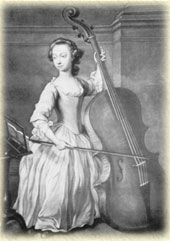
Boys wore skirts in the 18th century until almost age five, when they donned breeches and symbolically entered the man's world. Here young Benjamin Hallet not only is arrayed in a shirt, he is laced into stays to shape his body and encourage erect posture. Mezzotint was engraved around 1750 by James McArdell from a painting by Thomas Jenkins. 1979-313.
Both little boys and girls wore skirts, a practice that continued well into the twentieth century. Toddlers' frocks were often made with leading strings, long ribbons or fabric sewn to the shoulders of the bodice, that were used to restrain and guide a child learning to walk. As a consequence, they became a symbol of youth. Leading strings began to lose favor by the late eighteenth century. Dr. Buchan wrote in 1774,
"When children begin to walk, the safest and best method of leading them about is by the hands. The common way, of swinging them in leading-strings fixed to their backs, has many bad consequences," among which he noted obstructing the breathing, flattening the breast, and compressing the bowels, all caused when children inevitably strained against the restrictive stays.
The new philosophy about child rearing gradually had an effect on the clothing of older children as well. Around the mid-eighteenth century, the concept of dressing children to resemble "little adults" began to give way to clothing designed specifically for their needs. Instead of wearing the tight dresses styled similar to those of grown women, little girls and boys who were not yet breeched were dressed in more comfortable white cotton or linen frocks that had drawstrings tied at the back, low necklines, and often were decorated with wide, colorful sashes around the waist. Virginia children were not exempt from the new rage for white frocks. Fithian described his pupils in their white frocks with amusement. On a particularly cold day in July 1774, Fithian recorded that "the Girls too, in their white Frocks, huddle close together for the benefit of warming each other, & look like a Flock of Lambs in the Spring--I wish they were half as innocent."
The shape of boys' suits changed too. Instead of constricting outfits with tight bands at the knees and stiff high-necked shirts, they wore long trousers and shirts with open collars. These new children's styles had a wide influence on fashion. Older children increasingly wore them so that, by century's end, adult women dressed in white muslin gowns and grown men adopted trousers instead of knee breeches.
Throughout the period, the basic item of an infant's apparel was a napkin or clout, period terms for a diaper. "Diaper" was derived from the linen fabric often used to make it. Yard goods for babies' diapers were available ready-made in colonial stores; a 1751 advertisement in the Virginia Gazette announced that imported "Cloating Diaper" was available. Poorer families used recycled linen and rags. A 1789 book in which clothing necessary for the poor is listed suggests that a newborn be provided with twenty-four square napkins; the fabric recommended was "figured diaper." Diapers were often folded in a triangle, with the points brought forward over the baby's abdomen and secured with a straight pin. (Pins stuck into pincushions given as gifts were intended to be used, so only rare decorative cushions survived with all their pins intact.)
More enlightened mothers sewed ties to their children's diapers to avoid using dangerous straight pins. Such was the recommendation of the 1838 Workwoman's Guide, which illustrates a style of diaper tied on with tapes drawn through a loop.
To answer the need for leak-proof rubber pants, mothers used wool flannel squares, called "pilchers," over the linen napkins to absorb excess moisture, especially at night. Wool was chosen because it could absorb large amounts of moisture without soaking through or feeling soggy.
Infants were dressed in multiple layers of clothing. Over an undershirt and stays, a baby wore a pleated flannel petticoat and a slip topped by an outer frock or dress.
Head coverings were considered an indispensable item of children's apparel. Some children wore several caps at one time, with a plain white linen one being the undermost layer. A specialized type of cap for toddlers learning to walk was the "pudding" or padded helmet designed to protect the infant's head in case of a fall. Abigail Adams wrote to a friend in 1766, asking to borrow the quilted "contrivance" for her little girl "Nabby," just beginning to walk. She explained, "Nabby Bruses her forehead sadly[.] she is fat as a porpouse and falls heavey." The affectionate term "puddin' head" was derived from the pudding caps many toddlers wore. Williamsburg milliners advertised "Quilted Puddings for Children."
Milliners and other shopkeepers sold a variety of toys that proliferated on the market by the late eighteenth century. Playing with dolls helped little girls learn their future role in life and taught them the intricacies of fashionable dress.
Wealthy young girls sometimes owned very fashionably clothed dolls, purchased and dressed with great attention to detail by local milliners. These milliner's dolls were intended primarily as children's playthings, not "fashion dolls." Peggy Livingston, a five and one-half-year-old girl living in New York, received an elaborate doll from her Uncle Tommy, which he bought and had specially outfitted in London. Peggy's doll had a hair wig, pair of stays, handmade shift, petticoat, and handkerchief, and a dress designed and made by the milliner.
Linda Baumgarten is curator of Textiles and Costumes in the Department of Collections, Conservation, and Museums at Colonial Williamsburg. This article is posted with permission from the winter 1987–1988 issue of the Colonial Williamsburg Journal.